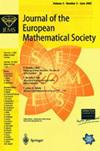Erdős-Szekeres多维数组定理
IF 2.9
1区 数学
Q1 MATHEMATICS
引用次数: 12
摘要
追溯到近一百年前的经典Erdős-Szekeres定理指出,任何(n−1)+ 1个不同实数的序列都包含一个长度为n的单调子序列。这个定理已经以各种方式推广到高维,但也许最自然的一个是由Fishburn和Graham在25年前提出的。他们定义了单调和列-单调数组的概念,并询问需要多大的数组才能找到大小为nx的单调或列-单调子数组….×n。Fishburn和Graham在这两种情况下都得到了ackerman型边界。我们显著改善了这些结果。不管维数是多少,我们在单调情况下最多得到n的三重指数界,在lex-单调情况下最多得到四重指数界。本文章由计算机程序翻译,如有差异,请以英文原文为准。
Erdős–Szekeres theorem for multidimensional arrays
The classical Erdős-Szekeres theorem dating back almost a hundred years states that any sequence of (n − 1) + 1 distinct real numbers contains a monotone subsequence of length n. This theorem has been generalised to higher dimensions in a variety of ways but perhaps the most natural one was proposed by Fishburn and Graham more than 25 years ago. They defined the concept of a monotone and a lex-monotone array and asked how large an array one needs in order to be able to find a monotone or a lex-monotone subarray of size n× . . .×n. Fishburn and Graham obtained Ackerman-type bounds in both cases. We significantly improve these results. Regardless of the dimension we obtain at most a triple exponential bound in n in the monotone case and a quadruple exponential one in the lex-monotone case.
求助全文
通过发布文献求助,成功后即可免费获取论文全文。
去求助
来源期刊
CiteScore
4.50
自引率
0.00%
发文量
103
审稿时长
6-12 weeks
期刊介绍:
The Journal of the European Mathematical Society (JEMS) is the official journal of the EMS.
The Society, founded in 1990, works at promoting joint scientific efforts between the many different structures that characterize European mathematics. JEMS will publish research articles in all active areas of pure and applied mathematics. These will be selected by a distinguished, international board of editors for their outstanding quality and interest, according to the highest international standards.
Occasionally, substantial survey papers on topics of exceptional interest will also be published. Starting in 1999, the Journal was published by Springer-Verlag until the end of 2003. Since 2004 it is published by the EMS Publishing House. The first Editor-in-Chief of the Journal was J. Jost, succeeded by H. Brezis in 2004.
The Journal of the European Mathematical Society is covered in:
Mathematical Reviews (MR), Current Mathematical Publications (CMP), MathSciNet, Zentralblatt für Mathematik, Zentralblatt MATH Database, Science Citation Index (SCI), Science Citation Index Expanded (SCIE), CompuMath Citation Index (CMCI), Current Contents/Physical, Chemical & Earth Sciences (CC/PC&ES), ISI Alerting Services, Journal Citation Reports/Science Edition, Web of Science.

 求助内容:
求助内容: 应助结果提醒方式:
应助结果提醒方式:


